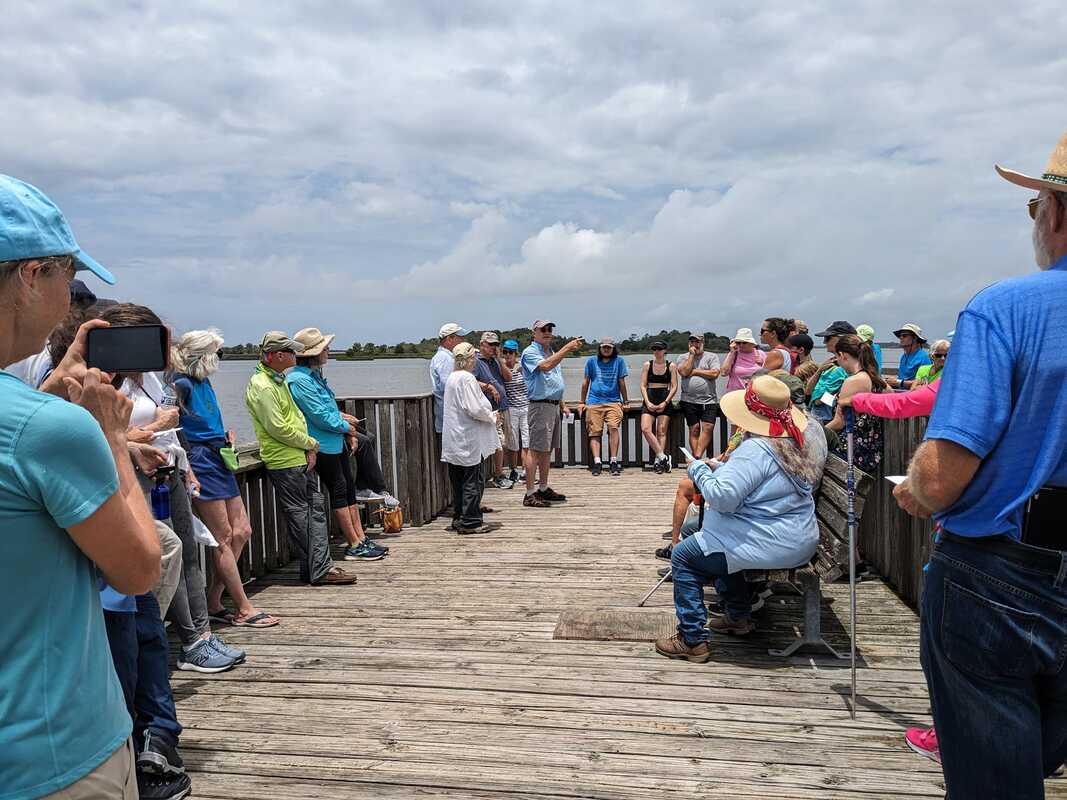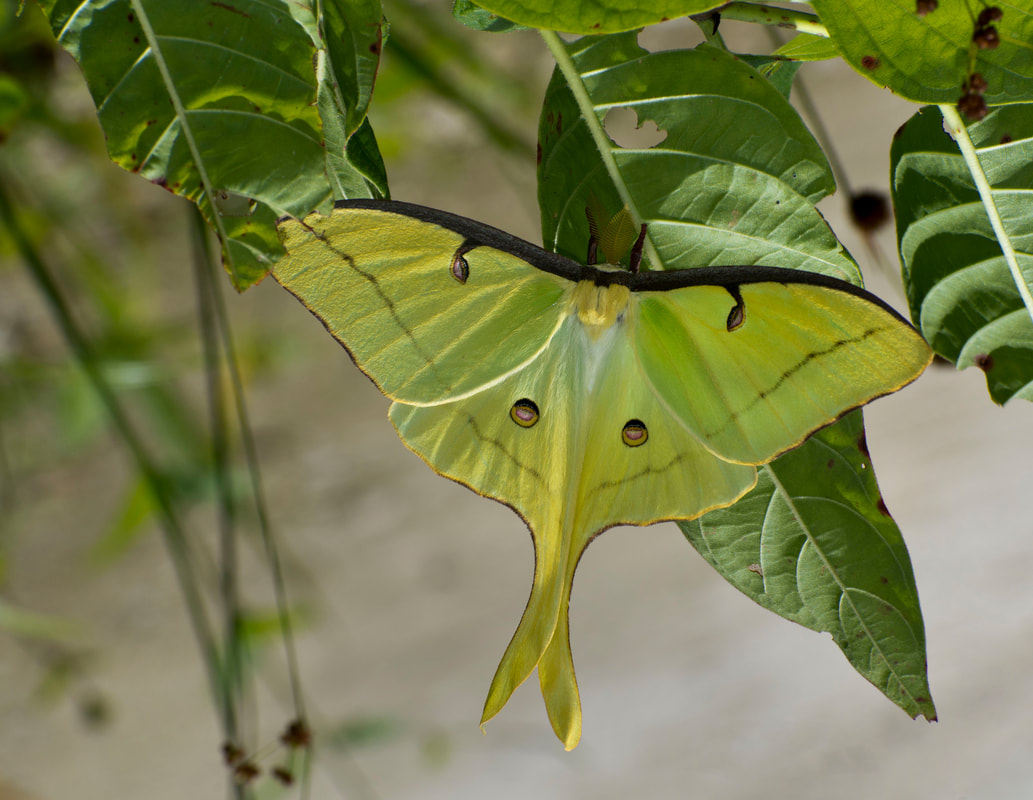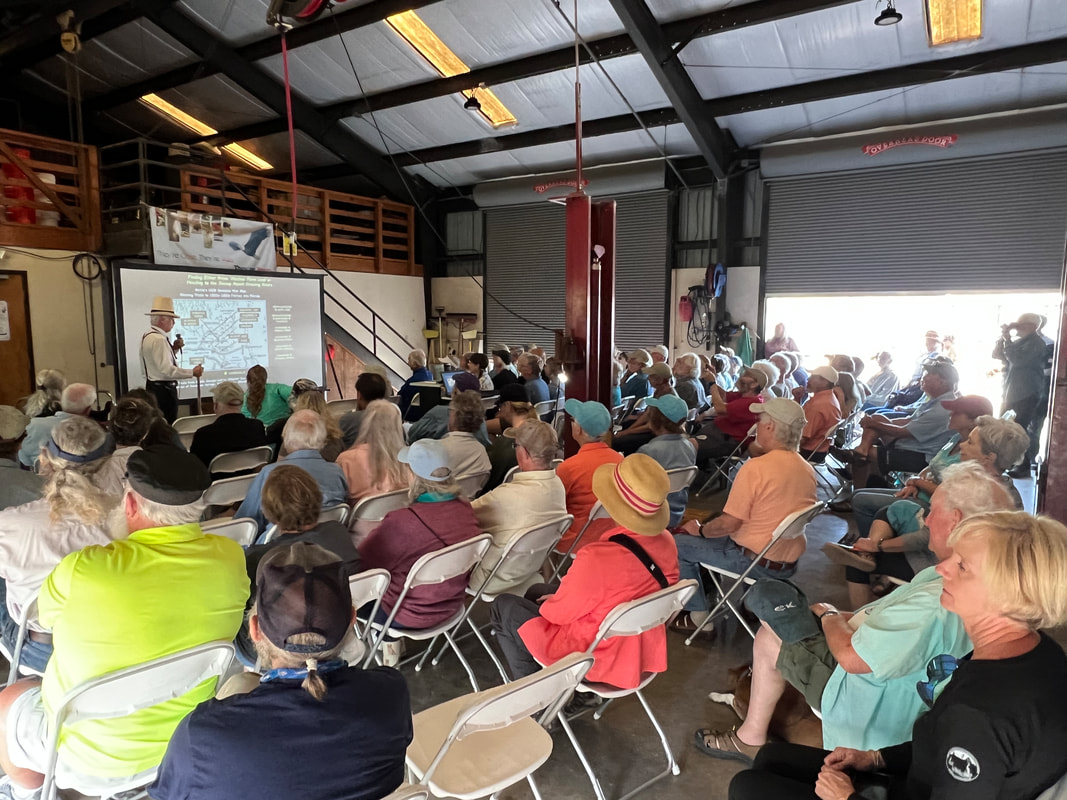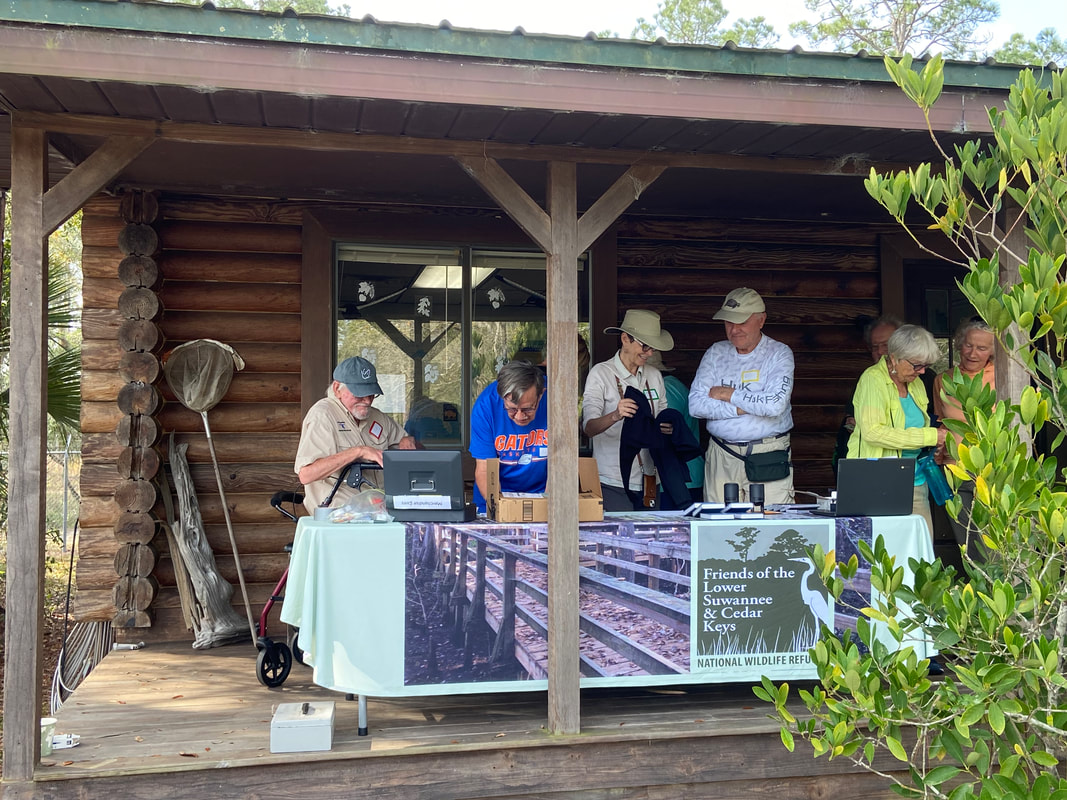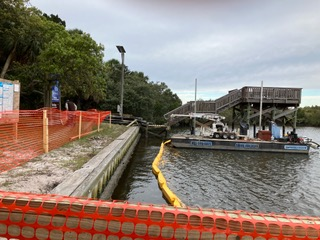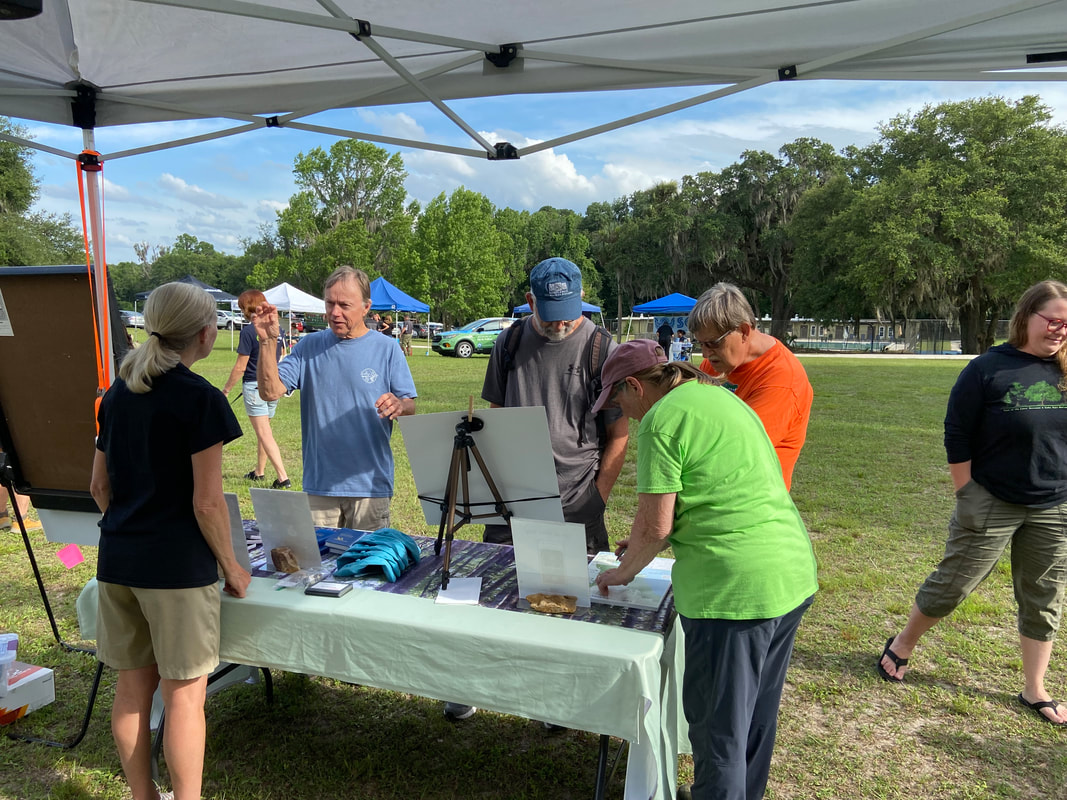|
Over 30 Cedar Key summer school kids enjoyed two days of Junior Ranger activities with Refuge Manager Andrew Gude and Deputy Manager John Stark who gave them an idea of what it takes to be a wildlife ranger.
Jeremy Geiger, a turtle expert studying with Friends former board member Dr. Travis Thomas, entertained the kids with turtle stories, facts, and show-and-tell artifacts. John described carnivorous plants and the variety of them that we have on the Refuge while Friends Past-President Debbie Meeks and Friends member Carol Lang showed the kids how to build a Venus flytrap using paper plates. Board member John McPherson lent a hand keeping everyone on track. Refuge Forester Daniel Barrand showed the kids how scientists measure plant diversity using the grid technique. Board member and butterfly expert Barbara Woodmansee led a mini-butterfly walk where the kids practiced using their binoculars. The older kids were even more interested in a puddle that was full of tadpoles.
0 Comments
Despite how it looks in the dramatic photo above, taken a few minutes before the talks began, the weather was kind this year for Friends' Summer Solstice celebration. More than 50 participants visited the Friends' information tent, heard the Seaside Talks by Dr. Ken Sassaman and Refuge Manager Andrew Gude, and walked the archaeology tours led Friends' President Dr. Ginessa Mahar and by Dr. Sassaman. During the talks and walks, the Gulf breezes were strong enough to keep many of the biting insects at bay. By the time the guided walks had finished, the breezes had died down and the potential for storms had disappeared. The archaeo-kayak tour co-sponsored by Friends, the Florida Paddling Trail Association and the Florida Public Archaeology Network began, led by Friends' President Ginessa, FPAN's Nigel Rudolph, and FPTA's Dorsey DeMaster. The kayakers visited prominent archaeology sites near Shell Mound, including Komar, to learn more about the indigenous fishing and shellfishing practices in the region over 1500 years ago. If you missed this amazing day at Shell Mound, watch for announcements for the celebration of Winter Solstice and come join Friends at Shell Mound in December. On Saturday, June 24, 2023, Friends of the Lower Suwannee & Cedar Keys National Wildlife Refuges, in partnership with the Florida Public Archaeology Network (FPAN) and the Florida Paddling Trails Association (FPTA), will celebrate Summer Solstice at Shell Mound. Activities include guided archaeology walks, a guided and space-limited archaeo-kayak tour, and a seaside talk on the pier. The event is free to the public. Registration is required for the kayak tour. Register using this Eventbrite link. All spaces are filled. Land-based events, held rain or shine: 1:00 Gather at the Shell Mound parking lot, Some may need to park at the Dennis Creek trailhead parking lot. Friends, FPAN, and FPTA will have information tables set up. Welcome by Refuge Manager Andrew Gude on the Shell Mound fishing pier. Seaside Talk by Dr. Ken Sassaman on the Shell Mound fishing pier. 2:00 Shell Mound walking tour -- The first group departs, guided by Dr. Ginessa Mahar. 2:15 Shell Mound walking tour -- The second group departs, guided by Dr. Ken Sassaman. 3:00 Information tables -- The Friends, FPAN, and FPTA will have volunteers at their tables to talk with participants after the seaside talk and the guided walks. Kayak Tour -- a space-limited event Participants in the kayak tour must register using this Eventbrite link. They will need to provide their own kayaks and equipment. They must wear a PFD at all times while on the water. 3:00 Kayakers registered for the guided kayak tour gather at the Shell Mound boat ramp with their kayaks and PFDs, which all paddlers are required to wear at all times on the water during the tour. 3:15 Registered kayakers depart for the tour, guided by FPAN archaeo-kayakers and Friends president and archaeo-kayaker, Ginessa Mahar. 6:00 Kayakers return to Shell Mound boat ramp. If this tour must be cancelled for weather-related safety reasons, kayakers will be notified via Eventbrite. To see photos and read about earlier Solstice events, visit the blog posts about the 2022 Winter Solstice celebration and the 2021 Summer Solstice celebration.
 Swallow-tail Butterfly - Photo Credit Frank Morgan Swallow-tail Butterfly - Photo Credit Frank Morgan The USFWS assistant forester from the regional office made a recent visit to the Refuge and commented that restoration efforts over the last 5-7 years have been critical to reforestation efforts and the improvement of pollinator habitat. He suggested the Refuge contract with someone to do vegetation diversity surveys as well as pollinator surveys to highlight the Refuge's restoration strategies. While forest health has been the primary goal of restoration efforts, the successes of rejuvenating pollinator habitat has been important to the overall ecological health of the Refuge and a joy to butterfly, bird, insect and wildlife enthusiasts, as well as hunters and anglers. Insects, especially pollinators, are key indicators of ecosystem health.
Well done, Refuge staff! Butterfly expert and board member Barbara Woodmansee has been working with Refuge staff and a few volunteers to survey the butterflies of the Lower Suwannee NWR. Her photos and expertise enabled Friends to produce our guidebook, Butterflies of the Lower Suwannee, with information on all the species that have been definitively documented to be on the Refuge . . . Until Now!! On Monday, June 12, 2023, she and her team spotted the Seminole Texan Crescent. According to Barbara: "This little beauty can be found in dark, swampy areas north, south and east of the Lower Suwannee NWR, but for more than 10 years, I have never been able to find one in the Refuge. Yesterday, we found 9 of them on the Nature Drive, and I hope they're here to stay"! Here is what to look for: Also seen and photographed by Barbara on this same survey day were:
Our Friends' organization has a successful relationship with U.S. Fish and Wildlife Service's Refuge staff. Our mission is clear: we exist to support the work of the Lower Suwannee & Cedar Keys National Wildlife Refuges to protect wildlife and the habitat needed for the wild to thrive. A recent article in the June 1st edition of the Levy Citizen describes the many projects past, present and future that the Friends organization has undertaken to protect and promote the approximately 55 miles of Refuge property along the Suwannee River and the Gulf of Mexico, and the 53,000 acres of forest on the Lower Suwannee NWR. The Cedar Keys NWR encompasses 13 islands accessible only by boat. These islands are managed as rookeries for colonial nesting birds, creating protected lands where birds can thrive. Click here to link to the Levy County Citizen's article to learn more about Friends and what to do and see on the Refuges.
One of the biggest hurdles our Friends group faces is a lack of visitor services infrastructure. The historic Vista camp will eventually be our permanent office but opening the doors to the public is a multi-year project. In the meantime, we hope to purchase a mobile welcome center that can be moved around the Refuge, allowing us to help visitors where they are. Several other Friends groups who set up trailers told us that they are a big hit with the volunteers who staff them as well as with visitors.
A funding opportunity popped up for this long-time wish list item and we applied. Every year the National Wildlife Association awards the O’Brien Prize to a Friends group whose project will help build a connection with their community. The grant is capped at $6,000 and we think we can outfit a 6’x12’ trailer for just under that amount. Our fingers and toes are crossed hoping we win the grant so we will be able to move ahead with this exciting project. Read our grant application here.
In March, Refuge Manager Andrew Gude nominated Friends of Lower Suwannee & Cedar Keys NWRs for the Year.
We should hear soon who wins this prestigious recognition. There are about 250 Friends groups nationwide. We would love to be recognized as a leader among them. Read the nomination letter here. The Refuge has three more Open Houses scheduled at Seahorse Key this year, in July, October, and November.
Visitors can walk up to to the Light Station and cross over to the beach on the far side of the island. It is a beautiful, adventuresome experience. Open Houses are free once you arrive at the Refuge island. However, visitors must arrange their own transportation. Shuttles are provided for a fee by tour companies in Cedar Key, or visitors can arrive by private boat. However, for the July 1 Open House, private boat tie up may not be available. See Andrew's note below. Note from Refuge Manager Andrew Gude
We have been rebuilding the dock at Seahorse Key. It is supposed to be finished by July 1, but such dates do tend to slip. If the contractor has not completely finished and pulled away, it will not be possible to tie to the dock. If you arrive on a private boat, you are welcome to keep someone on the boat while others get off or you can anchor off the front beach and walk up the hill. Also, It is important for visitors to note that Seahorse Key is an island almost 3 miles from Cedar Key. Access is only by boat. There are no amenities, such as food or water on the island. Restroom facilities are limited. Should there be a medical or other emergency requiring professional assistance or evacuation, response times could be lengthy. Please plan with this in mind. Seahorse Key is wonderful, but it is not a walk in the proverbial park. The Climate Fair was an outreach success. The weather was perfect. The venue at Cuscowilla Nature and Retreat Center was park-like. The 30 vendor booths had plenty of space and were set in a lovely, mowed- grass field, in a U shape. Visitors could walk around the U or crisscross back and forth. There were also several food trucks. We had more than 50 visitors to the Friends’ booth. Although many had been to Cedar Key and to Shell Mound, they didn't know about the Cedar Key Refuge nor that Shell Mound was part of the Lower Suwannee Refuge. They were especially curious about parts of Lower Suwannee Refuge where they'd never gone, and wanted to know what to do and see. They were interested in the background and purpose of the Refuge, and also in the Refuge as a climate-change mitigator for Alachua County. One visitor to our booth was Sam Johnson who has a TikTok vlog -- Hidden Florida. He had stumbled onto the Climate Fair after visiting Micanopy. He sent us this video, with permission to share it here.
Mark Gluckman, one of the Friends earliest members and a former board member, is a successful project planner and adept at forming community partnerships. Since we are taking slow steps toward preserving the Vista property, Mark generously contributed his time and expertise to help us visualize some of the amorphous ideas that have been discussed for nearly as long as the Friends have been in existence. We are grateful that we have a Friend like Mark who after participating in many Friends' discussions has developed a vision that will help in moving the Vista project forward. Below are Mark's concept drawings. More on how we've gotten this far with the Vista property project can be found in the blog reports that resulted from two State of Florida Historic Preservation grants that enabled us to hire the architectural firm Bender and Associates to conduct historical research and perform a structural assessment report. We are in an early phase of executing our second grant directed at stabilizing and weatherproofing the Cook’s House. Read more about Vista here.
|
Archives
June 2024
|

Friends of the Lower Suwannee & Cedar Keys National Wildlife Refuges
P. O. Box 532 Cedar Key, FL 32625 [email protected] We are a 501(c)(3) nonprofit organization. |
|





